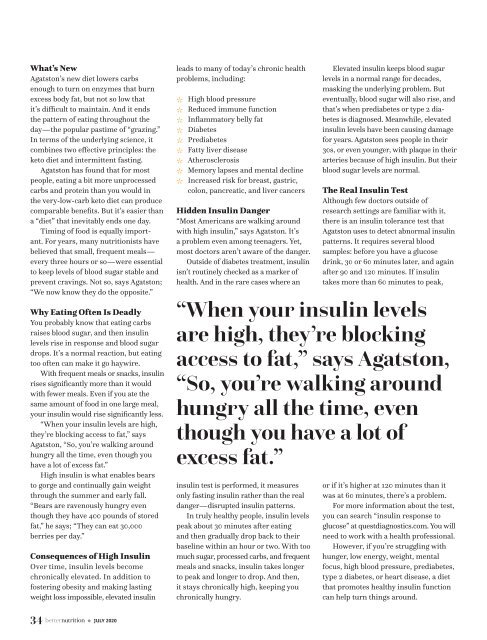You also want an ePaper? Increase the reach of your titles
YUMPU automatically turns print PDFs into web optimized ePapers that Google loves.
What’s New<br />
Agatston’s new diet lowers carbs<br />
enough to turn on enzymes that burn<br />
excess body fat, but not so low that<br />
it’s difficult to maintain. And it ends<br />
the pattern of eating throughout the<br />
day—the popular pastime of “grazing.”<br />
In terms of the underlying science, it<br />
combines two effective principles: the<br />
keto diet and intermittent fasting.<br />
Agatston has found that for most<br />
people, eating a bit more unprocessed<br />
carbs and protein than you would in<br />
the very-low-carb keto diet can produce<br />
comparable benefits. But it’s easier than<br />
a “diet” that inevitably ends one day.<br />
Timing of food is equally important.<br />
For years, many nutritionists have<br />
believed that small, frequent meals—<br />
every three hours or so—were essential<br />
to keep levels of blood sugar stable and<br />
prevent cravings. Not so, says Agatston;<br />
“We now know they do the opposite.”<br />
Why Eating Often Is Deadly<br />
You probably know that eating carbs<br />
raises blood sugar, and then insulin<br />
levels rise in response and blood sugar<br />
drops. It’s a normal reaction, but eating<br />
too often can make it go haywire.<br />
With frequent meals or snacks, insulin<br />
rises significantly more than it would<br />
with fewer meals. Even if you ate the<br />
same amount of food in one large meal,<br />
your insulin would rise significantly less.<br />
“When your insulin levels are high,<br />
they’re blocking access to fat,” says<br />
Agatston, “So, you’re walking around<br />
hungry all the time, even though you<br />
have a lot of excess fat.”<br />
High insulin is what enables bears<br />
to gorge and continually gain weight<br />
through the summer and early fall.<br />
“Bears are ravenously hungry even<br />
though they have 400 pounds of stored<br />
fat,” he says; “They can eat 30,000<br />
berries per day.”<br />
Consequences of High Insulin<br />
Over time, insulin levels become<br />
chronically elevated. In addition to<br />
fostering obesity and making lasting<br />
weight loss impossible, elevated insulin<br />
leads to many of today’s chronic health<br />
problems, including:<br />
*<br />
*<br />
*<br />
High blood pressure<br />
Reduced immune function<br />
Inflammatory belly fat<br />
* Diabetes<br />
* Prediabetes<br />
Fatty liver disease<br />
*<br />
* Atherosclerosis<br />
Memory lapses and mental decline<br />
*<br />
Increased risk for breast, gastric,<br />
*<br />
colon, pancreatic, and liver cancers<br />
Hidden Insulin Danger<br />
“Most Americans are walking around<br />
with high insulin,” says Agatston. It’s<br />
a problem even among teenagers. Yet,<br />
most doctors aren’t aware of the danger.<br />
Outside of diabetes treatment, insulin<br />
isn’t routinely checked as a marker of<br />
health. And in the rare cases where an<br />
insulin test is performed, it measures<br />
only fasting insulin rather than the real<br />
danger—disrupted insulin patterns.<br />
In truly healthy people, insulin levels<br />
peak about 30 minutes after eating<br />
and then gradually drop back to their<br />
baseline within an hour or two. With too<br />
much sugar, processed carbs, and frequent<br />
meals and snacks, insulin takes longer<br />
to peak and longer to drop. And then,<br />
it stays chronically high, keeping you<br />
chronically hungry.<br />
Elevated insulin keeps blood sugar<br />
levels in a normal range for decades,<br />
masking the underlying problem. But<br />
eventually, blood sugar will also rise, and<br />
that’s when prediabetes or type 2 diabetes<br />
is diagnosed. Meanwhile, elevated<br />
insulin levels have been causing damage<br />
for years. Agatston sees people in their<br />
30s, or even younger, with plaque in their<br />
arteries because of high insulin. But their<br />
blood sugar levels are normal.<br />
The Real Insulin Test<br />
Although few doctors outside of<br />
research settings are familiar with it,<br />
there is an insulin tolerance test that<br />
Agatston uses to detect abnormal insulin<br />
patterns. It requires several blood<br />
samples: before you have a glucose<br />
drink, 30 or 60 minutes later, and again<br />
after 90 and 120 minutes. If insulin<br />
takes more than 60 minutes to peak,<br />
“When your insulin levels<br />
are high, they’re blocking<br />
access to fat,” says Agatston,<br />
“So, you’re walking around<br />
hungry all the time, even<br />
though you have a lot of<br />
excess fat.”<br />
or if it’s higher at 120 minutes than it<br />
was at 60 minutes, there’s a problem.<br />
For more information about the test,<br />
you can search “insulin response to<br />
glucose” at questdiagnostics.com. You will<br />
need to work with a health professional.<br />
However, if you’re struggling with<br />
hunger, low energy, weight, mental<br />
focus, high blood pressure, prediabetes,<br />
type 2 diabetes, or heart disease, a diet<br />
that promotes healthy insulin function<br />
can help turn things around.<br />
34 • JULY <strong>2020</strong>

















